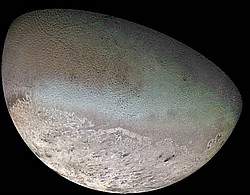
|
Title: Color Mosaic of Triton
Caption: A high-resolution color mosaic of Triton. Triton is one of only three objects in the Solar System, along with the Earth and Titan, to have a nitrogen rich atmosphere. It also has the coldest surface known in the Solar System at just 38 K (-235° C, -391° F), a temperature so cold that most of Triton's nitrogen has condensed as frost. The pinkish polar deposits appear to contain methane ice, which has reacted with sunlight. The overlying dark streaks are thought to be an icy dust deposited from huge geyser-like plumes, which are known to be active on the moon.
Copyright:(c) Public Domain
Credit: NASA/JPL
|

